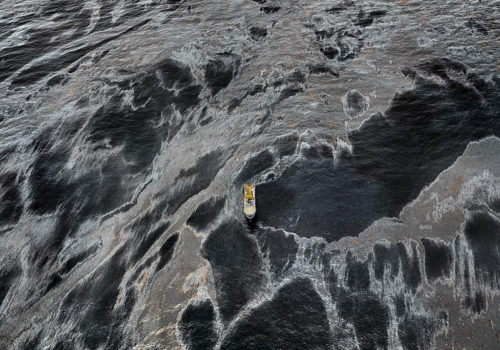When BP’s Deepwater Horizon well began pouring millions of barrels of oil into Gulf waters in May 2010, Edward Burtynsky travelled to the site to capture the disaster as it developed. Though characteristically visually spectacular (sublime is not too strong a word) and expressly an evolution of the photographer’s distinctive aesthetic, the images present something of a departure for Burtynsky, who has said of his work “I understand that it has an editorial aspect to it, but nothing I photograph is really a news event”. The Oil Spill images, while perfecting the grand-scale magnificence of Burtynsky’s body of work-to-date with their irreconcilable, bewitchingly surreal, startlingly painterly compositions, depict an event that is newsworthy even as it is alchemised into art in a blink of the photographer’s eye. As a result, there is a degree to which the pictures “charge Burtynsky’s typically long view with a not-quite typical topicality”, with ‘charge’ being the operative word: the photographer’s immersion in the events at Deepwater dispels any sense of ‘studied ambivalence’ or ‘cool detachment’ (accolades/censures often pinned on Burtynsky), energising not only the imagery, but the critical currents with which it is underscored.
While the photographs trace the same path as the newsreel and documentary images propagated by the worldwide media in the weeks and months following the spill, in many senses they seem to inhabit a different world. As with the Australian Minescape series of 2009, Burtynsky adopts an aerial view, capturing the sprawling site of the disaster from a seaplane. From this celestial vantage point, the surface of the ocean transforms into a reptilian skin of undulated azure, shot through with alien veins; channels of toxic viscosity. In scenes from May 12, oil and foam, billowing and clawing against one another in a battle for supremacy, conjure doomsday apparitions. Oil Spill #14, Marsh Islands depicts algae-inflected wetlands that appear like reverse shadow puppets against the slurry of the contaminated water; their curving, spiking forms – bilious hued against black – mimicking the form of dancing dragons. A watery umbilical thread with a rainbow aura conjoins two tankers as they flank the flaming derrick – a modern day firebird – in Oil Spill #5, Q4000 Drilling Platform resulting in a scene of mythic shock and awe. In both name and appearance, Oil Spill #7, Ground Zero evokes the cataclysmic scenes of 9/11, as an army of oil rigs hover on the surface of the ocean engulfed by noxious plumes, rising up like menacing fortresses or else razed in the apocalypse of humanity’s oil addiction.
Exhibited alongside the Oil Spill images will be a suite of prints produced from Type 55 Polaroid negatives taken as test-shots in the Chittagong Delta of Bangladesh, where Burtynsky shot his celebrated Shipbreaking series. Replete with the blemishes and scars of the photographic process, the images have a raw and painterly appearance and an intimate appeal. Opening his archive to the viewer by realising in print the becoming-image of one of his most celebrated bodies of work, Burtynsky shines an unprecedented light on the evolution of his imagery. The result is a captivating cache he has named Pentimento, a painting term that describes the ghost image lying beneath the work’s surface. For Burtynsky, black and white recalls the beginnings of photography, and as such these prints are an elegy to the antiquated operation of dismantling ships by hand. Burtynsky was haunted by the image of ships on the beaches of Chittagong, and these pictures allow him to further express the otherworldly quality of the place that they capture whilst giving his ‘ghosts’ a life of their own.
Edward Burtynsky Gulf Oil Spill & Pentimento
Until February 5
Flowers galleries
21 Cork Street
London W1S 3LZ
For further information and images,
please contact Chris Littlewood
+44 020 7920 7777
[email protected]
















